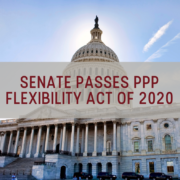Senate Passes PPP Bill Offering Flexibility on Forgiveness Guidelines
On Wednesday, June 3rd, the Senate passed the Paycheck Protection Program Flexibility Act of 2020. The bill was passed in the House last week with large bipartisan support and eases the strict guidelines currently in place to qualify for forgiveness of PPP loan funds. It will now move to President Trump for his signature.
As many recipients of PPP loans are approaching the end of their 8-week Covered Period, the bill offers important guidance and relief to borrowers looking to qualify for forgiveness of the funds. If the bill becomes law, recipients of PPP loans will now have an additional 16 weeks to use the funds for eligible expenses. The bill also provides more flexibility for use of the funds on “non-payroll” expenses.
A few of the major changes to forgiveness requirements appear to be:
- Extension of the Covered Period from 8 weeks to 24 weeks (or the end of the year, whichever comes first)
- Lowers the portion of PPP loan funds that must be used for payroll from 75% to 60%, allowing 40% to be used toward other non-payroll, eligible costs such as rent and utilities. There is a potential for no forgiveness (loan to be repaid) if 60% of the loan proceeds is not spent on payroll costs. This could be a significant change.
- Increases the maximum payroll amount for the extended Covered Period from $15,385 to $46,154 per employee
- Extends the Full Time Equivalent (FTE) and Salary/Wage Reduction safe harbor date from June 30, 2020 to December 31, 2020, which allows employers more time to restore their FTE count and Salary/Wage amounts to pre-COVID-19 numbers.
- Outlines additional FTE reduction exemptions for changes in business activity and allowing exemptions for borrowers who are unable to hire similarly qualified employees
- Extends the loan term of any funds not forgiven to 5 years from 2 years. Please note that for existing loans prior to the passing of this bill, both lender and borrower must agree to the change in loan terms through a refinance of the loan. The interest rate remains 1%.
- Allows businesses who qualify for loan forgiveness to also defer the employer portion of payroll tax, which would be paid in two installments (50% by 12-31-2021 and 50% by 12/31/2022)
- Changes the loan repayment deferral period to the date forgiveness is decided rather than 6 months from disbursement
- The Forgiveness Application must be submitted no later than 10 months from the end of the recipient’s Covered Period.
If President Trump signs the bill into law, PPP loan borrowers will now have to choose to either adopt the new 24-week Covered Period or continue with their original 8-week option. We would advise to look closely at your eligible expenses to date, payroll costs, and your FTE count, among other factors, when making this decision. There could be more changes forthcoming to the PPP loan program through additional legislation, as well as SBA and Treasury Department guidance.
Due to the changes the bill would introduce, the SBA Forgiveness Application will have to be updated, as well as other specific regulations/calculations from the original law. As the requirements for PPP loan forgiveness continue to evolve, we would suggest submitting your SBA Forgiveness Application at a time where it is most advantageous to your business.
Please contact your trusted Scheffel Boyle team member with questions. We are continually monitoring this situation and will provide updates as news is released. We are always here to help.



